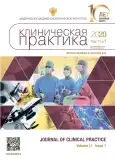Опыт создания публичной базы данных мутаций oncoBRCA: биоинформационные проблемы и решения
- Авторы: Никитин А.Г.1, Бровкина О.И.1, Ходырев Д.С.1, Гусев О.А.2,3, Гордиев М.Г.4
-
Учреждения:
- Федеральный научно-клинический центр специализированных видов медицинской помощи и медицинских технологий Федерального медико-биологического агентства России
- Казанский (Приволжский) федеральный университет
- Институт физико-химических исследований RIKEN
- ООО «Национальный Биосервис»
- Выпуск: Том 11, № 1 (2020)
- Страницы: 21-29
- Раздел: Фундаментальная медицина
- URL: https://journals.rcsi.science/clinpractice/article/view/25860
- DOI: https://doi.org/10.17816/clinpract25860
- ID: 25860
Цитировать
Полный текст
Аннотация
Обоснование. Развитие наследственных онкологических синдромов обусловлено генетическими нарушениями в системе репарации ДНК, состоящей более чем из 100 генов. Однако в настоящее время в большинстве медицинских центров России диагностика наследственных заболеваний раком яичника и раком молочной железы сводится к определению наиболее частых мутаций (8 точек) в генах BRCA1 и BRCA2 с помощью методов полимеразной цепной реакции. При этом данные мутации являются частыми для славянской популяции, в то время как в остальных популяциях России они встречаются реже или не встречаются вообще.
Цель исследования — получить представление о ландшафте наследственных патогенных вариантов в генах системы репарации; разработать методы быстрого анализа данных полногеномного секвенирования.
Методы. Методом секвенирования нового поколения (Next Generation Sequencing, NGS) была проанализирована панель из 34 генов системы репарации в 1644 образцах биоматериала пациентов с наследственными онкологическими синдромами. Результаты. Выявлены 119 патогенных мутаций генов BRCA1/BRCA2 у 374 пациентов, при этом обнаружена выраженная разница в частоте встречаемости мутаций между различными этносами — славянами, татарами, башкирами и чувашами. Созданы публичная база данных частоты мутаций и полиморфизмов генов системы репарации ДНК в различных этносах (https://oncobrca.ru), а также методы для автоматической параллельной обработки любого количества образцов от сырых данных до готового отчета.
Заключение. С помощью метода NGS появилась возможность выявления редких мутаций, характерных для различных этносов, что дает возможность назначать оптимальную химиотерапию и разрабатывать диагностические методы популяционного скрининга носительства мутаций генов системы репарации ДНК. Современные подходы к анализу данных полногеномного секвенирования позволили сократить время получения результата до нескольких часов после проведения анализа.
Ключевые слова
Полный текст
Открыть статью на сайте журналаОб авторах
Алексей Георгиевич Никитин
Федеральный научно-клинический центр специализированных видов медицинской помощи и медицинских технологий Федерального медико-биологического агентства России
Автор, ответственный за переписку.
Email: avialn@gmail.com
ORCID iD: 0000-0001-9762-3383
к. биол. н., заведующий лабораторией генетики
Россия, МоскваОльга Игоревна Бровкина
Федеральный научно-клинический центр специализированных видов медицинской помощи и медицинских технологий Федерального медико-биологического агентства России
Email: brov.olia@gmail.com
ORCID iD: 0000-0002-0946-7331
SPIN-код: 3631-1397
к. биол. н., старший научный сотрудник
Россия, МоскваДмитрий Сергеевич Ходырев
Федеральный научно-клинический центр специализированных видов медицинской помощи и медицинских технологий Федерального медико-биологического агентства России
Email: dmkh008@gmail.com
SPIN-код: 4292-7072
к.биол.н., старший научный сотрудник
Россия, МоскваОлег Александрович Гусев
Казанский (Приволжский) федеральный университет; Институт физико-химических исследований RIKEN
Email: gaijin.ru@gmail.com
ORCID iD: 0000-0002-6203-9758
SPIN-код: 5666-3711
к.биол.н., заведующий лабораторией экстремальной биологии; научный сотрудник
Россия, Казань; Префектура Канагавы, ЙокогамаМарат Гордиевич Гордиев
ООО «Национальный Биосервис»
Email: marat7925@gmail.com
SPIN-код: 8388-3566
директор по медицинской генетике
Россия, Санкт-ПетербургСписок литературы
- Torre LA, Bray F, Siegel RL, et al. Global cancer statistics, 2012. CA Cancer J Clin. 2015;65(2):87–108. doi: 10.3322/caac.21262.
- Sokolenko AP, Iyevleva AG, Mitiushkina NV, et al. Hereditary Breast-Ovarian Cancer Syndrome in Russia. Acta Naturae. 2010;2(4):31–35.
- Foretova L, Machackova E, Navratilova M, et al. BRCA1 and BRCA2 mutations in women with familial or early-onset breast/ovarian cancer in the Czech Republic. Hum Mutat. 2004;23(4):397–398. doi: 10.1002/humu.9226.
- Хасанова А.И., Гордиев М.Г., Ратнер Е.Ю., и др. BRCA-ассоциированный рак молочной железы у представительниц татарской национальности на примере клинического случая // Приволжский онкологический вестник. — 2016. — №2. — С. 104–108. [Khasanova AI, Gordiev MG, Ratner EYu, et al. Clinical report of BRCA-associated breast cancer among representative of the tatar nationality group. Privolzhskiy onkologicheskiy vestnik. 2016;(2):104–108. (In Russ).]
- Fackenthal JD, Olopade OI. Breast cancer risk associated with BRCA1 and BRCA2 in diverse populations. Nat Rev Cancer. 2007;7(12):937–948. doi: 10.1038/nrc2054.
- Matsuda S. Defective DNA repair systems and the development of breast and prostate cancer (Review). Int J Oncol. 2013;42(1):29–34. doi: 10.3892/ijo.2012.1696.
- Zook JM, McDaniel J, Olson ND, et al. An open resource for accurately benchmarking small variant and reference calls. Nat Biotechnol. 2019;37(5):561–566. doi: 10.1038/s41587-019-0074-6
- Miller NA, Farrow EG, Gibson M, et al. A 26-hour system of highly sensitive whole genome sequencing for emergency management of genetic diseases. Genome Med. 2015;7:100. doi: 10.1186/s13073-015-0221-8.
- Chen J, Li X, Zhong H, et al. Systematic comparison of germline variant calling pipelines cross multiple next-generation sequencers. Sci Rep. 2019;9(1):1–13. doi: 10.1038/s41598-019-45835-3.
- Van der Auwera GA, Carneiro MO, Hartl C, et al. From FastQ data to high confidence variant calls: the Genome Analysis Toolkit best practices pipeline. Curr Protoc Bioinformatics. 2013;43:11.10.1–11.10.33. doi: 10.1002/0471250953.bi1110s43.
Дополнительные файлы







